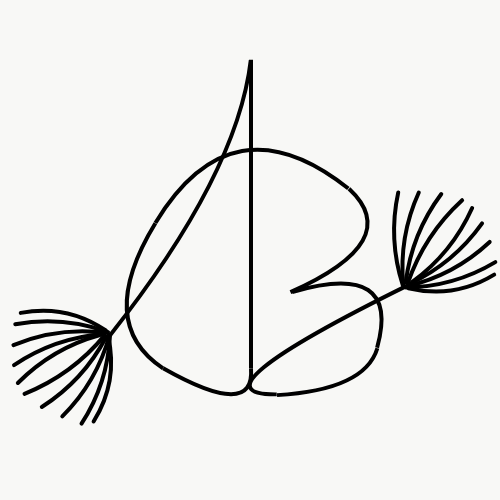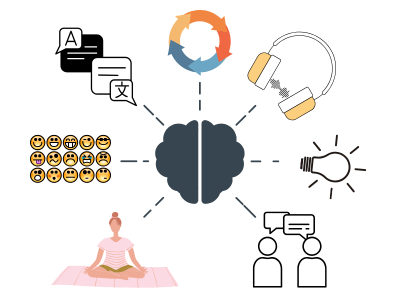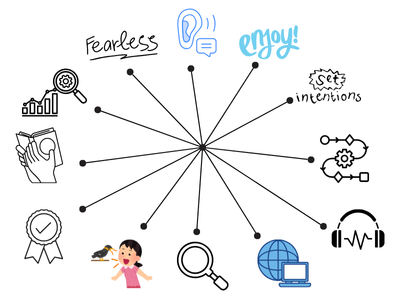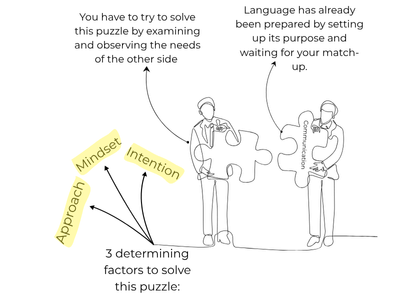Disclosure: This guide includes affiliate links through which I’ll earn commissions if you click and purchase because I recommended books and platforms to introduce the learners to the resources to utilize them in their learning based on their evaluations and preferences.
I love the independent way of learning because it gives me full freedom and control over my learning process and progress. Thus, I follow my system called Intuitive Absorption, which means subconsciously absorbing or acquiring a language through sensory immersion. And this intuitive absorption approach proceeds through four interconnected stages: Consumption, Absorption, Customization, and Exhibition. Let’s stride one by one below:
Table of Contents
1. What is Consumption in language learning?
Consumption is often described as the process of consuming things, it could be food, information, etc. But here we will use it as a noun that refers to the food itself, not the process of eating. In language learning, we will have the consumption for absorption. Consequently, knowing what the consumptions are in language learning is compulsory. So, I selected Listening, Reading, & Watching as three consumptions or foods for our language learning.
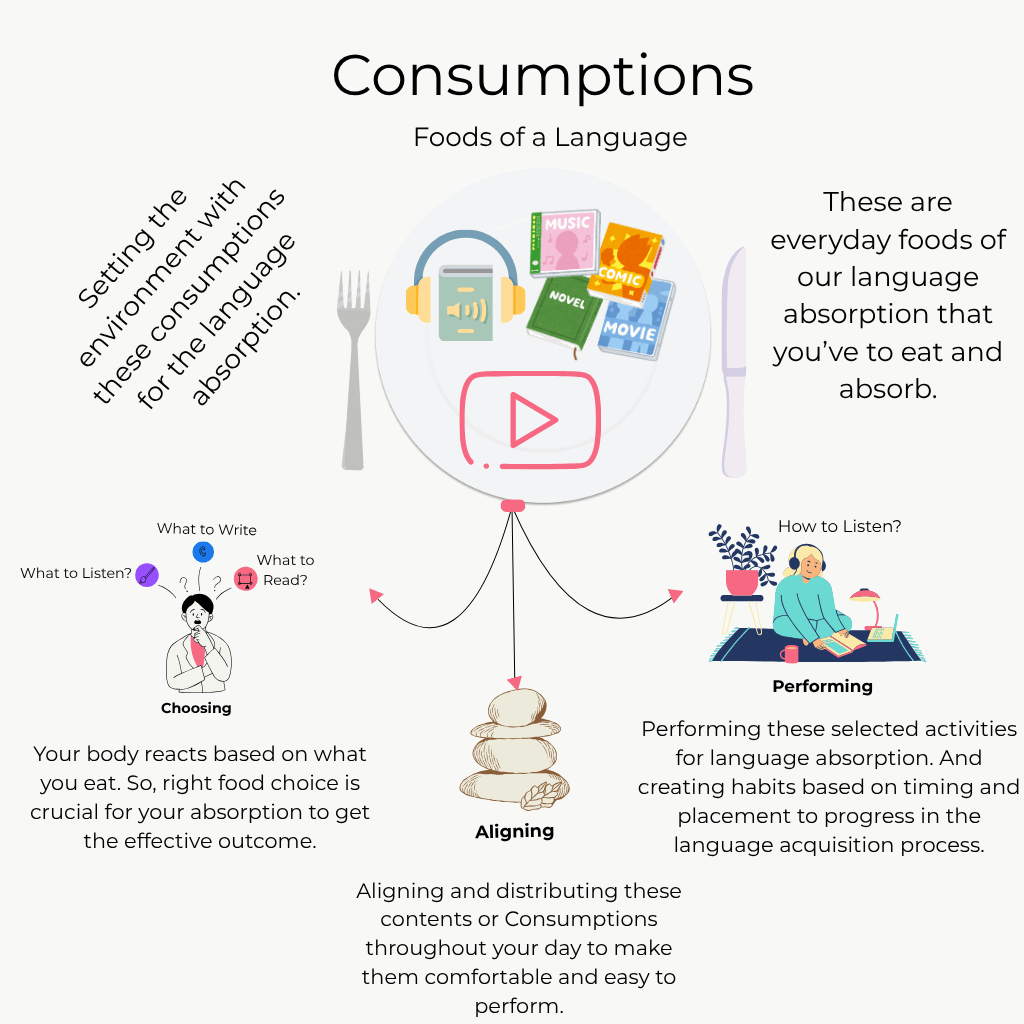
Generally, our body reacts based on what we eat, similar to how we learn a language according to our input. So, selecting our foods to eat or absorb in our language learning is crucial. Let’s do it by setting up the environment through selection, alignment, and performance.
Set up the environment to learn a language
The environment is such a thing we can’t ignore in anything due to its enormous impact and significance in our growth and learning. Many psychologists say that “You are the product of your environment” because our nature of mind observes the surroundings 24/7. In other words, what you input shapes your output. Exactly, for this reason we will decorate our surroundings and environment with these consumptions we’ve got before to make a system for language acquisition.
Selection
Selecting the contents or materials is an initial step for language acquisition. And we become panicked and blocked in thinking and choosing when we need to organize things before starting language learning. Let’s make things organized by focusing on our three major consumptions are Listening, Reading, & Watching. And we need to dig into them to find out the resources for each of them to get underway of learning. Now, for selecting materials we should maintain:
- Comprehensibility of the contents.
- Contents that are lovable, enjoyable that make you laugh, curious, crazy, and interested.
- Avoid sequencing, correction, and perfection because that makes you crave & stop. Remember, thing comes when it is needed.
- Focus on growth and development rather than accomplishment.
- Think simple, do simple, and live in simple because the simple is deep.
- Be real over motivations and emotions because they take control over you to enslave you in everything.
- You have the full freedom to choose and select your items by yourself from the description below:
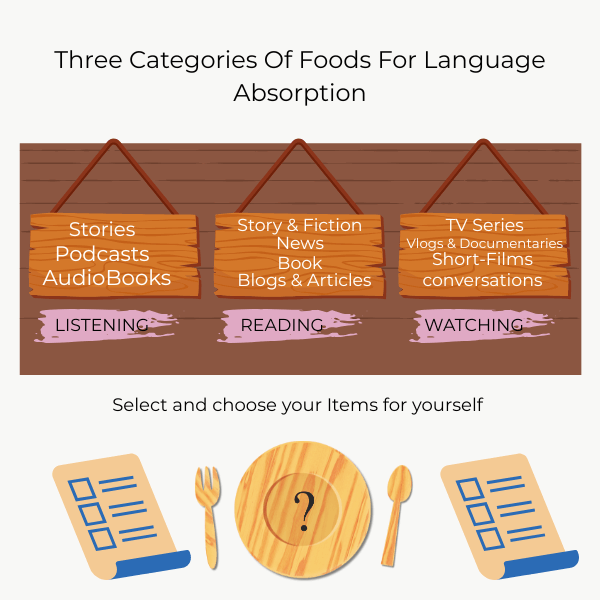
Listening
First start with the Listening: Listening has all sorts of impact in language acquisition. It contributes 70% of your acquisition and learning. Obviously, it earns the highest priority in our absorption or eating. So, my personal choice for listening are Stories & Podcasts + Audiobook listening. It could vary person to person but it has to be met with those points that I’ve described earlier. Furthermore, I would like to break them down to get a vivid image of what it looks like.
“Your listening skill will determine your speaking ability, even without practicing single word of speaking because it works like this through comprehension”
70% Effort: 70/100 = 0.70
(If you spend 3 hours a day for language learning, you have to spend 0.70*180 = 126 minutes for listening) not including break or rest time.
1. FOR THE STORY SELECTION: Stories are incredibly powerful tools for language learning They are connected to our genetics due to cultural and historical influence in it. Thus, you can see the importance of stories in religious, & scientific evolutions to persuade us, and in our daily actions and attractions: we instinctively love to listen and tell stories for emotional bonding. So, it’s great to utilize the stories in our language acquisition to stick on learning progress and process effortlessly. From a structural perspective two types of stories you can follow: Questions-based stories and Descriptive stories. Questions-based is fundamental for language learning that also known as a Foundational Input and Descriptive is as a Functional Input.
*Questions-based stories: These are story-telling or writing through asking questions and answering them. These are really fun to listen and read because they are interactive & conversational. Questions-based stories are foundational for language acquisition because in our daily conversations and communications we don’t need to give a speech to people but we do use short and precise sentences and phrases to express our thoughts; mostly asking queries or answering questions. i.e.
- They use solid structure with simple and short-sentences.
- The real world vocabularies that are used in conversations.
- These questions-based stories will be performed by Physical acting Method like a “Mummer” to express the meaning through their acting. We will know about it in the Absorption section fully that is coming soon. For now, you can learn about Blaine Ray’s TPRs Technique to get an idea about it.
- Fantastic people out there who work on short stories like Michel Rosen in English.
*Descriptive Stories: Descriptive stories are very engrossing and intriguing due to its nature of demonstrations with every detail. They don’t ask questions & answers but they do the narration of stories. (Round & Dynamic Narration of story that flows through changes which feels real and relatable. Ideal for personal growth.)
Requirements:
*Beginner: Questions-based
- Choose the questions-based story that short, simple sentences, understandable, and interesting that requires your attention.
- Length 10-20 minutes.
- It should be based on a real life scenario that feels conversational.
- If you choose a Funny story that will be great for your psychological health & language learning because it generates hormones that make you pressureless and intuitive.
- At least complete 20-25 short-stories to get the practical result with repetitions that will be discussed in the Absorption section.
Intermediate: Descriptive
- Choose a story that produces a meaningful message, yet functional, engaging and a little bit lengthy with slow narration to attract the senses to make things effortless.
- Length 25-50 minutes.
- It would be reflective, Imaginative, and emotional to feel it.
- It should be authentic and intelligible that makes sense: the true and real voice of the author.
- Descriptive stories are mighty effective for language acquisition because they stimulate the internal & external senses to connect with the story through vivid imagination, and visualization, etc.
*** Note: You can try your question-based & descriptive stories in different perspective to level up your language learning, which will be discussed next.
Additional
Perspective Stories: Perspective stories are modified versions of Question-based & Descriptive stories that use our creativity, changing the story’s structure from one perspective to another perspective. To get the fast and effective result you could try them, which I also call “Perspective Role-based Story-telling: Narrator narrates a story from various points of view and angles, where you’ll play a role in stories.
Perspective stories are functional that enhance the diversity of structural growth of an individual’s language acquisition, and also these stories aid the learner’s mind to think from different perspectives. Especially, for thought formation, learn to think in your targeted language. These stories are suitable for all beginner, Intermediate, and advanced learners and they are in two formats: Past and Present with a little mix of future.
In every language, the past is a vastly used format in daily conversations due to our present actions relatable to past actions. As a result, when we talk about something in the present, we drag and mix the past with it automatically. Thus, I think you should choose the story in the past format and should value it most. Then, present with the future to make things complete and perfect.
** Types of perspective narrations of stories:
- First person. 2. Second person. 3. Third person.
Types of third-person:
* Third-person Omniscient.(subjective = Internal)
* Third person Limited.(Subjective = Internal)
*Third-person Objective. (External)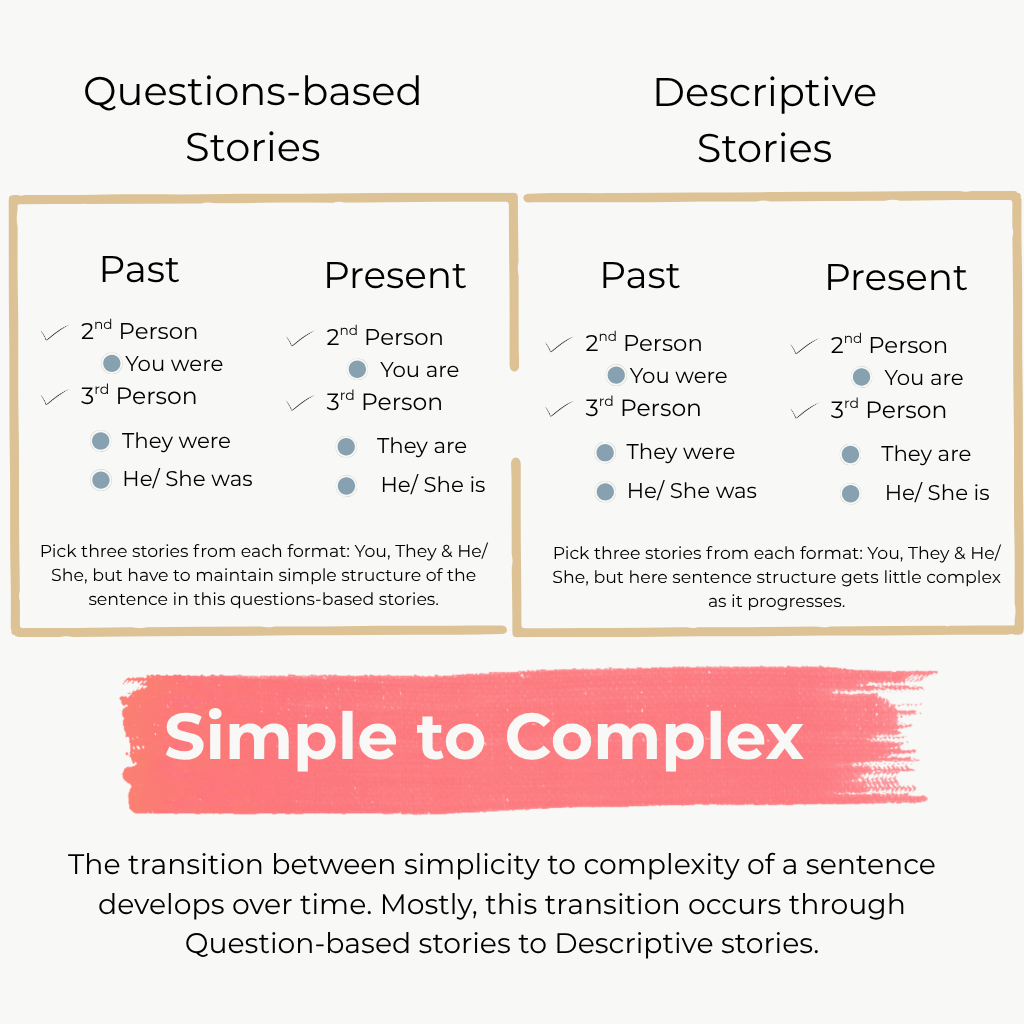
*First person (I, me, mine): we won’t use the first person story in our language learning because when we listen to the 2nd person narrative, it will cover it.
*Second person (You): Listening to the second-person narrative is extremely immersive. It is an easy one for applying the “Inferring Method” based on contexts to become familiar with the language that will be discussed in the Absorption section.
*Third person (He, She, They): The 3rd person narrative is the most prominent source of our language acquisition. Its diversity of character and in-depth narrative style makes it a major source for learning. The third person has three types:
- Omniscient: The human version of God Eye (Third Eye); narrating a story from God’s perspective means the narrator has a God’s eye that knows everything about the story internally and externally. Such as knowledge about a character’s internal feelings, thoughts, ideas, intentions, etc as well as external events of a story.
- Limited: 3rd person limited, also called “Third person omniscient limited”, always follows one character very closely and describes everything by sticking to him/her.
- Objective: The 3rd person objective narration narrates from the outside angle of a story, doesn’t dive into the inside of a character due to the limitation of knowledge (Kind of a spying the Story through observations), and this type of narrative is very rare in use and intricate too. We will avoid this narrative in our learning because 3rd person omniscient & limited covers everything.
I’ve mentioned two formats of perspective stories: Past and Present, with a little mix of future. And they’re applicable for both question-based & descriptive stories. Let’s dig deeper into that below:
*Past Format: Everything in a story will be in the past events.
- Second person narrative in the past: Suppose, you have done and event before and now you’ve been revising it through the narrator’s narration by listening to it in the balcony. For example, you visited a coral island a few months ago, and now rewatching it through you mind.
- Third-person Omniscient narrative in the past: Think about you were with a couple on a trip to the beach as an invisible character and had been following and watching everything from an invisible point. Now, you’ve been revising and rewatching everything again from your vivid imagination while sitting on the sofa. For example, they had been hanging around the beach for a while that they forgot about their dinner, and hurried up to their Hotel to change their outfits to go to the restaurant.
- Third-person Limited narrative in the past: Here, you will play an invisible role similar to the 3rd person omniscient but with limited vision. Such as, you were invisibly following someone’s trip to the Countryside of Japan and with him/ her had a friend also, but you were close eye on his/her feelings, thoughts, desires, etc.
*Present with a little mix of future Format:
- Second Person narrative in the present: Think that you are visiting the island and exploring everything by yourself in the present moment. The narrator will narrate everything by mentioning you and you have to feel that your “I”.
- Third-person Omniscient narrative in the present: You are invisibly following the journey of a couple on the Beach presently. Means the narrator has been narrating internal and external events of the story, and you have been listening to the narration by laying in the bed and using your senses to feel that you’re also hanging around with the couple on the beach as an invisible character.
- Third-person Limited narrative in the present: You’ve been following someone’s journey very closely, which means your attention is mostly dedicated to him/her. You’ve the full knowledge about him/her internally and externally, rest of the events are vague to you. Such as, Narrator narrating the story by limiting to one character’s internal and external actions, emotions, and feelings, and you’ve been listening to it by walking in the room and feeling that you are also joining to him/her as an invisible friend; looks like obsessing with one character so much that your attention to other becomes blur.
REQUIREMENTS:
BEGINNER: Question-based perspectives
- As for the beginners, you should apply the perspective story to the Question-based stories as well.
- You can change the angle of your view toward your previously selected short question-based story, which means trying the same story with different points of view (past to present to future). For this, you could hire someone or take the assistance of A.I Technology.
- You can also make-shift your choice by choosing a different story with the same simple style. For example, you selected a short story, one from the past point of view, and another one from the present & future.
INTERMEDIATE: Descriptive perspectives
- You’ll find plenty of perspective stories from vigorous story-writers in the market who make things easy for us.
- Then, search it on YouTube to listen to the audio. If you do not find it, you can use converter sites & apps or ask someone to make a voiceover to it.
*** For the initial stage of language learners should start learning with question-based stories to build their base of a language because they are simple, conversational & interactive. and every day you will have two periods of listening to stories, one in the past format, then in the present. For example, you choose “you were and you are” and after you acquire a full comprehension of these stories, you can replace them with “They were & They are” and then, “He/She was & He/She is”. And repeat this pattern 15-20 times to acquire mastery in the initial level of a language.
Then, after the beginning stage of liberation of a language, you can step into the descriptive stories listening to upgrade your acquired level because they are designed with more complexed sentences that develop your language expressions and thoughts to communicate uniquely. Now, you have to repat similar pattern that you’ve done before with the question-based stories 20-25 times to get the desired result in your language acquisition.
**Become an independent learner: You’re the learner and you’re the teacher of you. Doesn’t matter what language you want to learn (English, Spanish, Arabic, French, Japanese, ..) just collect the stories based on the chart I’ve given you and convert you story’s Text into Voice. Remember, you should complete the number of stories that I mentioned below, + maintain the repetition cycle.
*** Question-based stories:
From the past and present format:
YOU were (3 stories) + YOU are (3 stories).
THEY were (5 stories) + THEY are (5 stories).
HE/SHE was (4 stories) + HE/SHE is (4 stories).
**Note: Each story should be in a simple structure.
*** Descriptive Stories:
From the past and present format:
YOU were (4 stories) + YOU are (4 stories).
THEY were (5 stories) + THEY are (5 stories).
HE/SHE was (4 stories) + HE/SHE is (4 stories).
** Should be a little more complex structures than question-based stories.
*** Where to collect stories for language learning?
Solution is simple. Just search stories in your targeted language limited between (1000-5000) words based on perspectives that I said earlier, like ask the ChatGPT “: 2nd/3rd person narrative short-story words between 1000 to 4000 in English or Spanish, etc.” Then, you will find a list of stories. Choose which one you love and are interested in (scientific, Moral, Humorous, etc.) Next Step, to listen to these stories, you have to turn the story’s Text into Voice. WE will use Artificial Intelligence to our advantage to voice over our stories to listen to. The benefit of this strategy is that you have full control on your learning: you can choose your story by yourself that you’re interested in + The voice you want: funny, energetic, soothing, calming, poetic, etc. Or favorite persons voice: actor/actress, influencer, several platforms that has that options for you.
*** Using A.I Softwares for our story selection:
- Perplexity.
- ChatGPT-4
- Gemini
- Grok
- Claud a.i
- DeepSeek
- Copilot
*** Platforms for converting Text into Voice: Technological advancement makes our lives one step ahead of traditional settings. We can allow ourselves in everything we want, love, and care. And exploring is the source of finding curiosity that connects us with the things that amaze us through contemplation.
Just explore the platforms I’ve mentioned below because one thing leads to another, we never know through exploring these where we will be connected to go further beyond our intention, such as exploring them for language learning to using them into various pursuits. If you find them interesting, explore. If not, skip them.
***Platforms:
- Speechify
- ElevenLabs
- Artlist.io
- Epidemic Sound
- Murf.ai
- etc.
And if you want a more authentic, real voice + customized story writing for your language learning, you could hire someone from Marketplaces that offer this type of service. Such as, Fiverr, Upwork for stories and Voices, Bodalgo for voice-over.
Additional: If you want to hire a language teacher, you can explore trustworthy websites where experts of different languages help you to learn your target language. Quest someone who follows a natural, organized & clear approach. Particularly, a story-based learning system.
The best and ultimate way is learning a language fast through real people interactions which will be expensive, but effective and simple. Investing 2 hours a week with someone is better than spending 8 hours in the classroom. Deal with someone who’s conversation is better than you, neither too much advanced nor too less. Exactly, who can handle you through changing vocabularies, ideas, according to your level.
***Language learning platforms:
- Preply. (Professional)
- Lingoda. (Versatile)
- Babble. (Organized)
- italki. (Affordable)
- Rosetta Stone. (Immersive)
- Verbling. (User-friendly)
***Courses on learning a new language:
- British Council.
- Skillshare.
- Udemy.
- Thinkific.
- Coursera.
- Teachable.
- For The Podcast Selection: In general, language is our expression of thoughts that we build through perceptions. That means we need to learn how to think in targeted language. For this, the podcast is an optimal solution for becoming acquainted with the targeted language because the podcaster will generate his thoughts through this language and you will adapt with it by listening overtime.
REQUIRMENT:
*BEGINNER:
- Choose a Podcast that is is relevant to you by topics, easy concepts, simple thoughts, and short sentences with a slow pace.
- Avoid scripted podcasts.
- Choose someone who maintains natural rhythm with simple structure, conversational tone, and focuses on discussion.
- Someone who talks from personal experience.
- Don’t need to understand 100% of the speech, just guess the hints for the meaning.
*INTERMEDIATE:
- A podcast that is informative, relevant, and dedicated to specific topics like spirituality, self-help, science, etc.
- A podcast that evokes strong emotions and works as a guide to your perceptions.
- Real, authentic & truthful discussions that maintain the flow of thoughts.
- Someone virtuous, real, trustworthy, energizing, and exciting who makes you anticipate listening to them. + Can give you real-world vision & love of truth.
***Professional Platforms that are great for Podcast listening:
- YouTube.
- Spotify.
- Pocket Casts.
- Apple Podcasts.
- Google Podcasts.
I don’t want you to focus on the structural aspects of a Language except for a very tiny amount of use to select the stories based on a chart I’ve given you, because it distracts and disturb the process of your language acquisition. Let the intuitive process acquire them by itself to use them fluently and effortlessly in real-life situations. The benefit of the Intuitive Absorption approach is building self-reliance and self-mastery.
** Here I didn’t discuss anything for Advanced learners because it is a decoration of the foundation that has to be in the formational section of a Language; the exhibition or flourishing stage of a Language, where an individual feels liberated. Such as Accent building, voice training, developing thoughts through writings, speech making through logic(logos, pathos, ethos) and Rhetoric, literacy acquisition, etc. You will find them in my other writings.
3. For The Audiobook Selection: Although it is optional, it’s up to your choice & time, + you can replicate audiobooks with the podcasts in your scheduling, but emphasizing each of them separately is important depending on your needs. I think it’s a great way to enhance your language skills and expand your knowledge on topics deeply. Listening to audiobooks not only benefits us in language learning but also introduces us to the fundamental aspects of life, like sake as life, relationships, happiness, etc. Especially books that assist us in breaking the shackles of limited beliefs to see the world from different points of view. In addition, listening to a fiction story series will make things immaculate.
REQUIREMENT:
*BEGINNER:
- Fiction Story series that are short & simple like Aesop Fables. Particularly used for kids.
- Short, between 7-15 minutes each chapter.
*INTERMEDIATE:
- An audiobook that is written in a clear and direct voice + an author who values the reality of things rather than generalizations.
- Following the quality writings will determine your quality as well.
- Listen to story series like Harry Potter, Hardy Boys, Nancy Drew, in English language. and El Sendero del Guardabosques series, Percy Jackson and The Gods of Olympus, in Spanish, as an intermediate boost to your acquisition significantly due to functional and interactive writings.
***Note: Don’t read translated books due to cultural diversity and differences. Thus, listen to a book that has been written in your targeted language, like if you are an Australian and you want to learn Spanish, you should not read an Aussie literacy story book translated into Spanish because of the differences in tone, emotions, style, perceptions, way of expression, etc.
***Platforms for audiobook listening and a full series of storybook listening in multiple languages:
- Audible.
- Storytel.
- Apple Books.
- OverDrive.
- Hoopla.
Reading
*NOW FOR READING SELECTION: Reading is a unique and credible activity we do in language learning. It’s a lifelong learning tool we will build through language learning that not only empowers our mind to think sharply, but also see things precisely. But e overlook reading quite often due to not knowing its significance. In the same way, we ignore reading in language acquisition as well. Reading contributes to 20% of our language absorption. It looks tiny, but when we count its impact in the long run, it accumulates into bigger portions.
20% Effort: 20/100 = 0.2
(0.2*180 = 36 minutes for reading every day if you spend 3 hours a day on language acquisition.)
More importantly, language learning has a starting point that lasts forever. For example, through language learning we start to make habits of Listening, Reading, Writing, And speaking, even we begin to perceive the world, cultures, people, etc. So, it’s high time to set up the reading materials that aid our language learning impactfully and effectively.
(4 reading aids: News Reading, Blogs/ Articles reading, Story book & self-help book reading.)
- For the Story and Fiction book selection: Every section of language learning is immensely influenced by stories because they bring effective consequences for language learners. The characteristics of the stories are creative, versatile, and conversational. Specifically, reading an extensive amount of storybooks from genres you love and are interested in will give you a strong reading ability due to their richness in vocabulary and expressions. In addition, the creative flow of actions and reactions with the intriguing twists of story plots will keep you on track to return to the page every day for reading.
In the Listening section, I’ve discussed the types of Perspective Stories, and here we will implement these perspective stories once again in our reading to get the greater impact in our language acquisition. I couldn’t express how effective they are, if you don’t experience it. In particular, reading a full series of book s that benefits us in many ways.
We already know that perspective stories are in two formats, past and present, with a little mix of future. Let’s break down more:
*Past Format:
- 2nd person past: “You were.” Find out storybooks that are written from 2nd-person perspectives. Such as novels that have been narrated in the 2nd person past point of view: “If on a Winter’s night a traveler” by Italo Calvino in English. “Las cosas que perdimos en el fuego” by Mariana Enriquez in Spanish.
- 3rd person past:
- They were: Search storybooks that are written in 3rd person omniscient perspective. Such as, “Pride & Prejudice” by Austen Jane, ” The Complete Short Stories of Ernest Hemingway: in English language, and “Ficciones” by Jorge Luis Borges in Spanish.
- He/She was: Collect books that are written in using 3rd person limited. For example, “Dubliners: by James Joyce is in English.
*Present Format:
- 2nd person present: You are. Get books that are written in 2nd person narration. For example, “Self-Help” by Lorrie Moore in English, “Le viste la cara a Dios” by Gabriela Cabezon Cammara in Spanish.
- 3rd person present:
- They are: Choose books that are written in 3rd person omniscient narrative in the present. For instance, “Stories of Your Life & Others” by Ted Chiang in English. “El llano en llamas” by Juan Rulfo In Spanish.
- He/She is: select story books that are written in 3rd person limited narrative in the present. For example, “Nine Stories” by J.D. Salinger in English. And “Los perligros de fumar en la cama” By Mariana Enriquez in Spanish.
REQUIRMENTS:
*BEGINNER:
- Read the story book that is written in simple language with short sentences on straightforward ideas for the kids, mostly for fun and creativity.
- Try to avoid storybooks that are combined with many stories at once that are very short (50 to 200 words) because they might lose your energy and emotions of reading, as well as their punchline after every story, which would brainwash you and misinform you. They use motivational punch lines rather than realistic ones that lead us toward craving and comparison, which makes us confused.
*INTERMEDIATE:
- It should be conversational and navigable.
- Select a story book with the purpose in mind to use it for developing skills like sleuthing to observe daily actions out of curiosity. For example, the Detective story book series Hardy Boys, the Mystery book series, and Harry Potter.
- Fiction reading based on genres like mystery, sci-fi, etc. It’s better to stick to one genre to benefit from it. Such as reading mystical fiction books to develop self-awareness and self-realization.
***Platforms to find your Books to read:
- Amazon
- GoodReads
- Ebay
- Kobo
- AbeBooks
- Alibris
- Barnes & Noble
- IndiGo
- For the News selection: The modern inception of News reading in language learning increases the strength of learning fast and effectively. The importance of news reading is extremely valuable both from a language learning and a self-perspective. It uses professional and persuasive language with clean structures & vocabulary that are demonstrative, useful and descriptive, which aids the learner’s perceptions and language acquisition.
REQUIREMENT:
*BEGINNER:
- Simple sentences + easy ideas.
- It’s optional for the beginners, but many quality YouTube channel uploads and share news reading you could follow.
*INTERMEDIATE:
- Don’t choose chaotic news because they are destructive that causing mental health issues and thought conflicts due to an overload of unnecessary information.
- Choose reflective news about various cultures, people, and creative worlds like science, technology, philosophy, etc. + You have to ensure that they’re comprehensive, and a little bit complicated sentences based on your acquired level for your absorption.
- Choose news that is thoughtful, useful, and meaningful.
***Platforms: Read News in multiple languages:
- PressReader.
- Flipboard.
- Readly.
- Magzter.
- Apple News+
- Google News.
- For the Book selection: reading books is not only mere text reading for language learning, but also mind reading of the authors because they put insightful thoughts that they’ve got from years of dedication through persistent observations and examinations. choosing books is crucial for mind and language development. Our input system defines everything from your types of vocabulary and thinking.
REQUIREMENT:
*BEINNER:
- Choose self-help books due to their readability and teachability. They are very straightforward, simple language with short paragraphs and descriptive by breaking down ideas into many chapters.
- Read slowly and stride thoughtlessly. Don’t require full understanding of words’ meanings; if you find difficulties, shift to another paragraph. By the time it’s understood through repetition.
- Never read a textbook due to its scripted design model that extinguishes your curiosity and excitement.
*INTERMEDIATE:
- Try to get books on topics that are interesting and engrossing to you + qualitative writing.
- Always try realistic ones rather than motivational and emotional ones. Specifically, avoid theory or rule-based books because they can sometimes instill fear and limit our beliefs, thereby restricting our freedom to think outside the box, whether in science or religion.
***Platforms for selecting your favorite books: Revisit a few paragraphs.
- For the Blogs and Articles selection: Finally, we’ve got the Blogs and Articles, the most distinctive and free-style reading for everybody. They are very conversational and give you a personal touch that keeps you engaged to the contents. Nowadays, the personal branding in blogging creates opportunities for the learners and readers to choose anyone to follow by their interest.
REQUIREMENT:
*BEGINNER:
- Blogs are exceptional for beginners to begin their reading because they’re pieces of open-minded written conversations.
- Follow well-written, trustworthy content.
*INTERMEDIATE:
- Articles suit the intermediate level learners because they’re informative and knowledgeable.
- You could use them intentionally due to variations in topics and persons for learning and growth.
***Platforms:
- Medium.
- Quora.
- Pocket.
Watching
The one word that perfectly describes the role of watching in language acquisition is ‘handy’. Its impact depends on the learner’s approach and language itself. In the language world, you’ll find matching languages that they’re very close to each other due to geographical factors like distance and mixed influences of many languages through people’s communications and interactions in businesses and other purposes,. For example, learning English and Dutch are close languages. This type of language can be learned with little effort, even through watching videos or months of real-life interactions. Anyways, for typical language learning, 7% of effort in watching systematically will make a difference that you’ll feel by yourself due to the reason that visual perception influences our throughs to form through matching geometrical shapes you will know deeply about it in the Absorption section while discussing the topic “Vision”.
I prefer TV series, Conversation, Short-films, Vlogs, and Documentaries for language acquisition.
7% Effort: 7/100= 0.07
(0.07*180 = 13 minutes for watching)
- For the TV series selection: Anime TV series are great for language acquisition because they’re addictive, conversational, and animated: lots of actions & movements always buzzing around that keep your eye stuck in the scene. They are very effective for deep learning because repetitions of scenes help your brain for adaptations.
REQUIREMENT:
*BEGINNER:
- Watch TV series that are made for kids and try to complete a full series to get the impact on your acquisition.
- Choose by your interest and passion.
- Make watching easier to access.
*INTERMEDIATE:
- Choose TV series that are made for adults, it could be anime, mystery like Harry Potter, etc.
- Always maintain an interactive and conversational tone to watch.
***Platforms: TV series in multiple languages you can explore.
- Lingopie
- HBO Max
- Netflix
- Hulu
- Apple TV+
- Disney+
- For the Vlogs and Documentaries Selection: Another vigorous option we can explore for our language learning is watching Vlogs and Documentaries to increase our visual understanding of language. In addition, Vlogs are beginner-friendly and very interactive, resembling VR playing in the Eye that finely contributes to our conversation and negotiation skills as well. More than that, we can learn about many cultures, places, communities, etc, which teaches us to reflect on our own lives. Documentaries are much more compact and informative they educate us deeply.
REQUIREMENT:
*BEGINNER:
- YouTube is a great platform to engage with the Vlogs that you want.
- Follow someone consistently for impactful acquisition + who is interactive and informative.
*INTERMEDIATE:
- Follow Documentaries that explore the historical and cultrual aspects of the wolrd & human lives.
- You can chose someone who explains comprehensively in an appealing way.
***Platforms:
- YouTube.
- Kanopy.
- For the Short-films selection: The most delicate and exciting choice you can make by selecting a short film for your language learning. It comes with loads of benefits: they’re short but complete with starting and ending, perfect for watching, considering our 7% effort. They maintain professionalism in conversation, accent, use of vocabularies, moderate structures, etc.
REQUIREMENT:
*BEGINNER:
- Start with simple and easy-to-understand short films.
- Focus on enjoying, rather than learning. Don’t need to scrutinize everything. Overall understanding is the key to accumulation of scenes.
*INTERMEDIATE:
- Topic-wise selection of short films to stay on point to build vocabularies, expressions, thinking patterns, etc.
- Repetitions encourage gradual improvement in our understanding of things.
- For the Conversation selection: finally, the anticipated one that I’ve been waiting to share and discuss. In every activity we do in language learning, requires conversational content. Besides, we can try conversation episodes to take advantage of our learning that are made for learning daily conversations. These video episodes have great effect on our language acquisition because they create scenarios based on our daily life, which we often encounter. Such as a conversation in the market.
REQIREMENT:
*BEGINNER:
- Choose a short episode that maintains natural rhythm, short sentences, and informal conversations.
- Choose any character form a conversation, then watch it. Next time, change the character.
*INTERMEDIATE:
- Select a lengthy one between 20-30 minutes.
- A little bit of advanced conversation that is more formal.
Now this is the time for your selection. Think about the whole thing as a buffet where you’ve three categories of foods: Listening, Reading, and Watching. Inside each category are options/items that I’ve described previously form which you have to choose items for yourself.
REQUIRMENTS:
*BEGINNER: choice depends on the efforts of the individual.
Start with easy and simple, don’t overdo/rush anything. Choose 3 to 4 items from 3 categories.
- Listening = Questions-based story.
- Reading = Story books + blogs, news(optional)
- Watching = Vlogs & Documentaries.
*INTERMEDIATE:
Observe and track your learning to find the items over time.
- Listening = Descriptive story + applying the Perspective story.
- Reading = Fiction story bok + Articles/News reading + reading.
- Watching = Short film + TV series, etc.
Take your food on your plate and follow the next step of aligning.
Alignment
Aligning is an essential step after selecting items for your language absorption. Alignment is a broader sense than adjustment, it means aligning a full day of actions one by one. To do this, the most preferable method we can follow is the Shackling method to design our actions and items appropriately throughout the day.
Alignment occurs according to our feelings, and feelings rely on the evaluation of the value of action to react and reflect. For instance, if we have 10 actions to do in a day, we have to spread them throughout the day: Morning, Noon, Afternoon, Evening, & Night. For spreading these items, we need to maintain two things: Ordering & Adjusting.
Now, we have a selection of items on our plate, then we need to order and adjust them.
- For the Ordering: I don’t recommend sequencing things except depending on contexts, and here it will be used as an initial process of adjustment that we’ll know later. Ordering requires your judgment of the item’s value and importance, which will create a serial or list.
The source of evaluation is our intention & experiment, based on which our list of items is made. Such as which actions are more important to you depends on your purpose or Goal, put them all at the front line of your day. And if you don’t find it or struggle to judge and evaluate, then experiment with actions & items to have it by the time.
**I think it’s important to note that actions and items have a distinction. Such as, in language learning actions refer to main activities: (Listening, Reading, Watching) and inside of each action has many options which I refer to as items (listening = stories, podcast, etc.)
Let’s order our language learning materials based on values and importance:
*Actions:
- Listening.70%
- Reading.20%
- Watching.7%
*Items: list based on importance.
Stories.
Podcasts.
Storybook reading.
TV series.
Etc.
- For the Adjusting: adjusting is the process of tuning things, and here we want to fine-tune our serial or list that we made from our evaluation. In quest of the best fit and find tuning, two factors play a vital role, which are Time & Place, because every individual has their feelings and conveniences that relate to time and place. For Example, someone loves the morning for their workout at their home, and someone would be in a different time zone and place
Timing: I find that time has a connection to our mood and our mood swings with the flow of time and emotions. Such as, anyone could find morning as their productive & proactive period, and someone at night. It varies depending on an individual’s preferences and comforts.
Timing also gives us the psychological advantage to become effortless.
Despite being important, any item can be shifted to another point or position in your list due to your mood and feelings, according to timing & placement. For example, listening to podcasts has a great effect on language acquisition, and you want to put it in the morning, but your mood and feeling don’t go with that because you enjoy listening in the afternoon. so, you have to fit it in the afternoon to get the best attention and outcome from it.
- Stories listening in the morning.
- Reading at noon.
- Podcasts listening in the afternoon.
- Watching at night.
Placement: Timing without a place setup will make your work halt. Sometimes, it could be disgusting to do due to overthinking. Thus, I follow the technique called “One thing for one use” which means use one place to do one activity. Such as, listening podcast in the bed in the evening, reading story book in the balcony in the afternoon, etc.
Now, wrap up the whole thing to create the shackle and chain of our actions with our items to perform.
Performance
Here, performance suggests the physical reaction and state of your body while you perform a task. To make things effortless, I try to do things as predictably as possible by aligning the tasks through ordering and adjusting. In addition to that, I set the specific body movement or reaction for each task to become fully intuitive like listening while walking. For example, listening to podcasts in the evening in bed while sitting, reading a self-help book in the afternoon on the balcony while sitting in a chair. The main point is the more you make things specific, it becomes much easier to do.
Another psychological game I play to make things effortless is to take your main activities as a second-hand priority. Such as listening to short stories while walking in the morning , where I prioritize over language learning to get rid of every sort of pressure from language learning by transferring it into walking. It will be demonstrated in the Absorption section thoroughly while discussing the role of Physical Acting in language absorption.
Finally, we’ve concluded a very simple yet realistic and effective idea: Selection + Alignment + Performance = Pre-set up before starting language acquisition. Select the contents that you need, then align them by using the Shackling Method to perform it daily. Please, try to avoid psychological thought conflicts and discomfort due to the desire for immediate results.
2. What is Absorption to learn a language?
Absorption means sucking out things steadily. For example, being wet and drenched after diving in the water for a while. More practically, put your dry dress into a bucket of water and see how it drenches and absorbs into the water gradually. Similarly, in language learning, we put ourselves into the environment we set through consumption: (listening, reading, & watching ), then live into it through sensory immersion day after day to let the brain absorb and suck out the language intuitively.
Language immersion is the best way to learn a language because it doesn’t require memorization and urgency; rather, it requires sensory immersion and attention.
Immersion
Immersion is the act of involving deeply into something through using the senses. Generally, we use listening, seeing, feeling, tasting, and smelling as the five senses in our actions. We may also use imagination, reflection, recollection, etc. These senses are the gateways of our being, living, and perceiving.
Here we will use sensory immersion method to aid our perception of a language to use it effortlessly in real life scenarios. In the context of language learning, we break down immersion into two categories: 1. Immersing into the day. 2. Immersing into the content.
Immersing into a day:
For language learning we’ve got three consumptions or exposures previously in our discussion on consumption section. They are listening, reading, watching. And immersing into a day meaning decorating your full day with those exposures through alignment based on timing & placement. Then, perform them separately by applying an immersion method.
Immersing into the content:
Immersing in the content of a language is the ultimate involvement in our acquisition. And this immersion proceeds through Vision, Repetitions, Familiarization, Imitation, Adaptation, Comprehension, and Expression.
Vision
Visioning has multiple meanings depending on context. In a general sense, having access and capability to see things through eyes, or the perception to see things from experience and intuition. And I would like to represent the word ‘Vision’ in both ways: visioning through the eyes and visioning through the mind(Imagination).
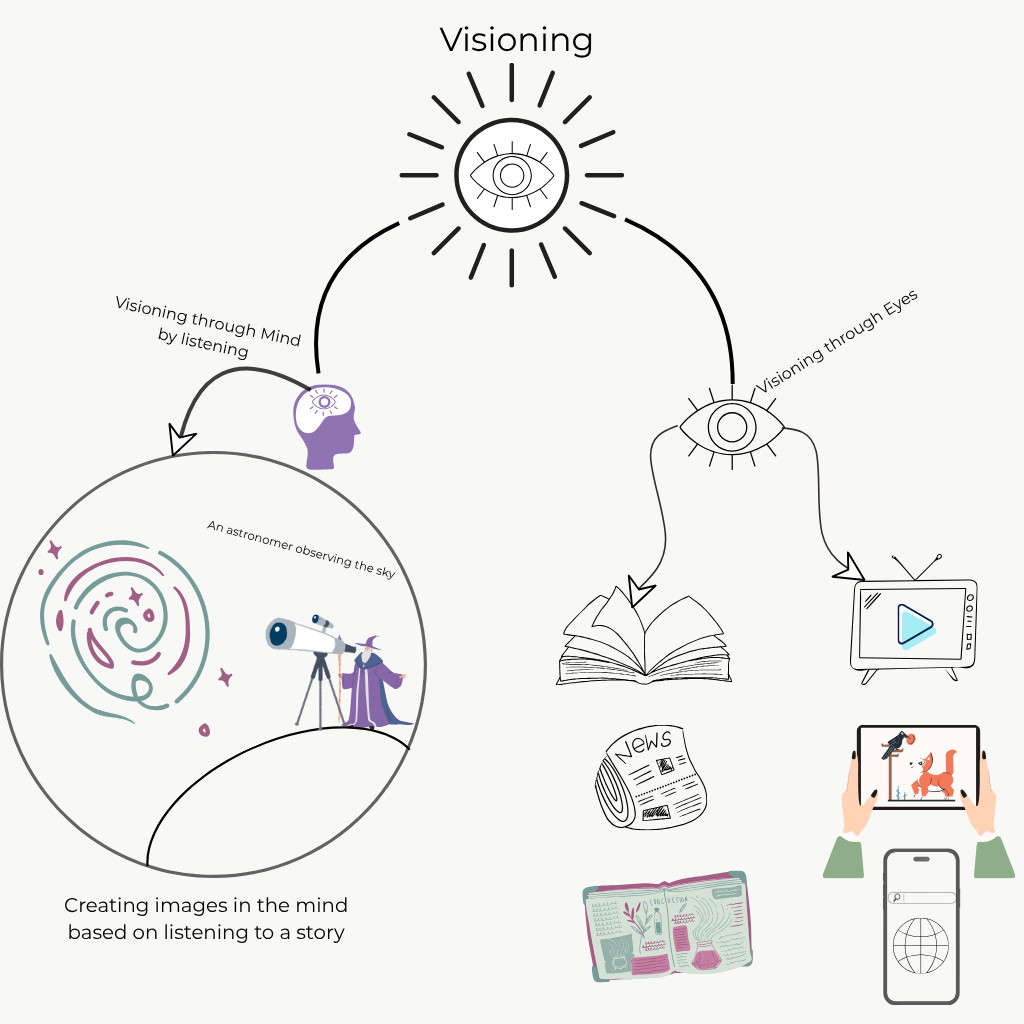
Visioning is an integral for the immersion into the content of language learning because the mind and eyes are involve in everything. Almost 90% of information involves visioning. In the consumption section, we find three foods of a language are listening, reading, and watching. And in all three activities use the mind and eyes. Such as, in watching we need use of our eyes to see the scenes and in listening, the mind sees things through imagination based on comprehension of the meaning. It’s really difficult to understand how one can understand meaning only through listening. Right? it’s completely up to the system to answer it below:
Visioning through the mind:
Visioning through the mind means using imagination; creating images according to your understanding of the expression and meaning of a language while listening. Such as, in the case of listening to a perspective story or question-based story, we need to understand the meaning of the story to create an image in our mind to see it. For example, listening to the story of coral island where the narrator describes everything in full of details, and to create images based on his narration, we will have to apply the Inferring or guessing method to grasp the meaning of the words and sentences gradually to make scenes of it.
Inferring method: Inferring means interfering or interrupting into things in the middle. And in language learning we will interfere and enter into the story’s narration to guess the meaning silently based on the contexts. For this you have to be passionate enough to guess the meaning completely through repetitions. In the first time of listening to a story fully, you can grab the meaning of a few words and based on that you would create an overall scene of this story. Then, after several repetitions you might find it more vivid and understandable because repetitions of the same action will determine your progress of comprehension.
Visioning through the eyes:
Seeing through the eyes is simple, just watching scenes on your screen and moving your eyes through the words and lines of a book’s pages.
Repetition
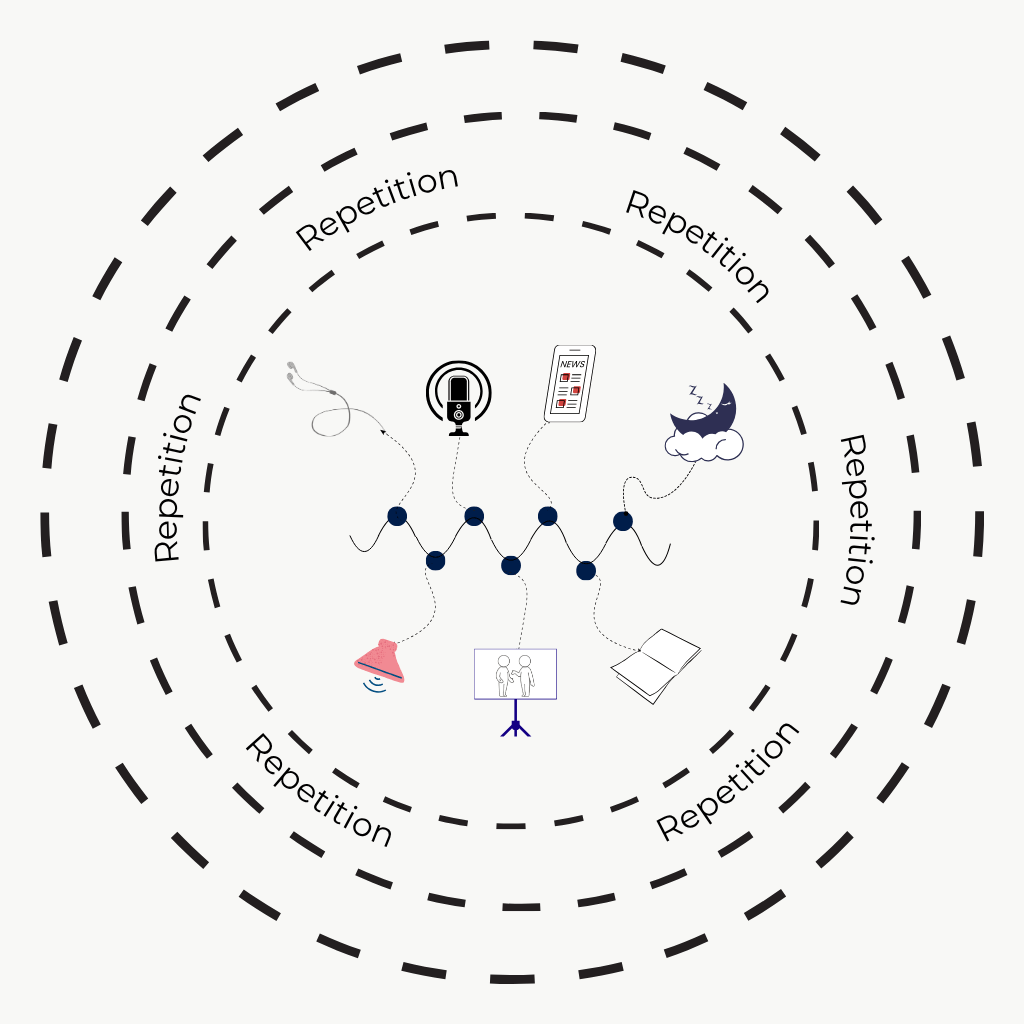
Repetition is the act of doing the same thing again and again or doing the same thing more than once. So, we will repeat the actions of visioning through the mind and eyes ( listening & reading ) to become familiar or acquainted with the content/materials. It might feel boring to repeat but experiencing the benefits it possesses are immense. You’ll experience new things in your every repetitions that steadily will reach you toward familiarization of the content. To repeat an action motivation requires to be filled. And motivation are two types: internal motivation and external motivation.
Internal motivation: it is a motivation that comes from inside of us through digging deeply into the actions by resonating and questioning. To repeat an action in language learning, internal motivation is mandatory. Such as, few things bring out inner motivation from an individual automatically if the content is funny, relatable, interesting, and pressure-free.
External motivation: motivation that arises from outside. For instance, why are you learning a language? Why is it needed for? The answers will determine your motivation level to perform the action repeatedly.
Familiarization
Familiarization is the process of increasing knowledge about a particular thing by spending time. It’s like a clearing out of a vision gradually in the dark after being in the light. Such as, when we spend time in the light for a decent period and then if we go outside in the dark immediately, we will experience the exact phenomenon that our vision is not clear enough to see things clearly, but you can understand this if you spend time in the dark first: the more you started to spending time in the dark after being in the light, the vivid your vision will become and be regained.
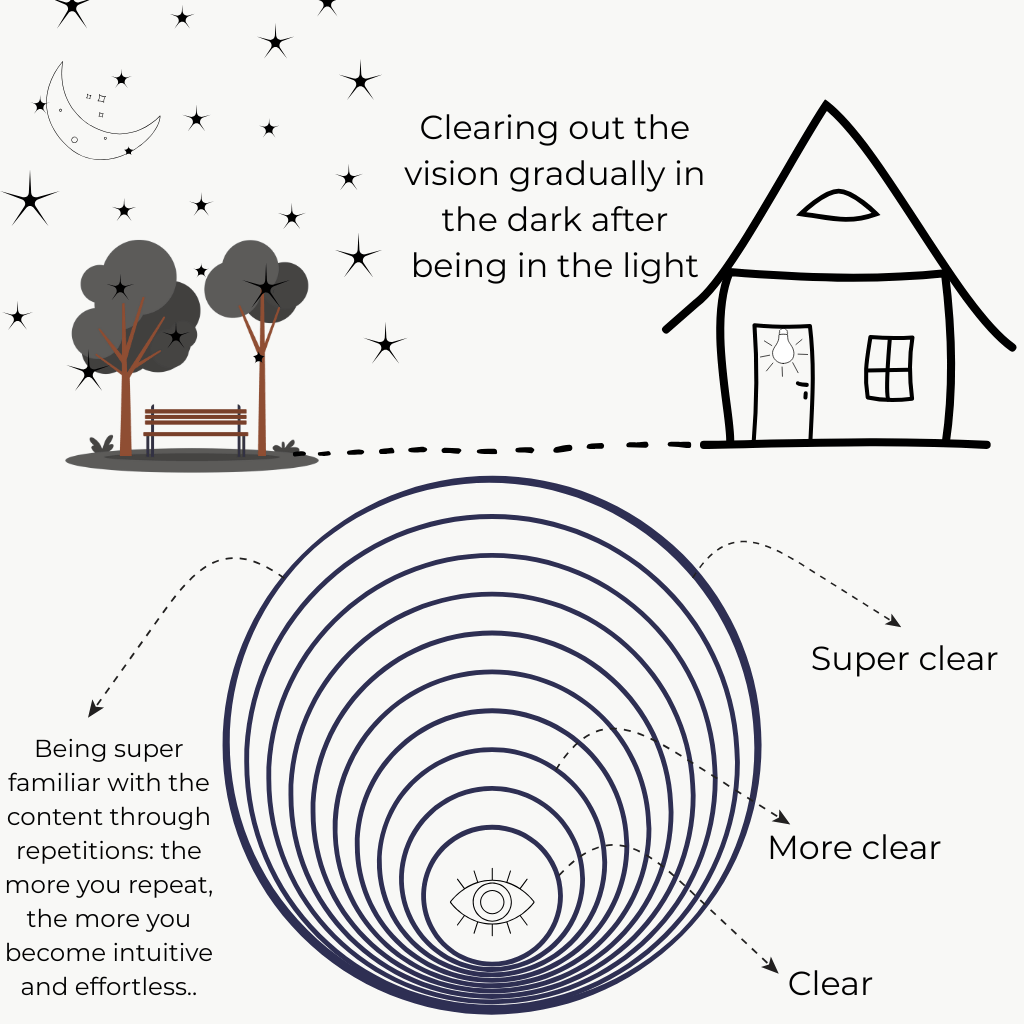
In language learning exactly the same way we will become acquainted with the content by repetition. The more we repeat an action, the easier its content will become. And the familiarization happens after weeks of repetitions of an action. For example, listening to a story for seven days will improve your 40% of understanding about it which will prepare you for Imitation through physical actions.
Imitation
Imitation is the replication of another’s behavior consciously and subconsciously. It’s an art of mimicry that is used in many cases such as in learning. In language learning, Imitation is consciously copying or parroting one’s speaking, writing, and acting. Subconscious imitation is also known for ‘mirroring’, which is important for cultural evolution and religious manifestation beyond genetics; for instance, virtues, certain teachings, etc. Or finding similar behaviors in the siblings, which often happens unconsciously because humans are prone to imitating others in their actions historically to adapt culturally and socially.
Anyway, after being familiar with the story through several repetitions, we need to step up to imitation to parroting or shadowing the story’s narration by using physical expressions. Now, shadowing/parroting is the copying of the narrator’s narration: you need to repeat the sentence loudly after the narrator finishes his sentence. If you struggle to do this, you need to extend the repetitions silently until you feel a little more comfortable and familiar with it.
Think about a filter which has few layers to clean up the water/comprehension and the familiarization is one of the layers that process your understanding of a story’s meaning through repetitions. One week of repetition silently will make you familiar and then 1/2 weeks of repetitions with the parroting or shadowing technique will enrich your comprehension further. Now, you need to apply shadowing technique with the physical expressions according to the meaning of the sentences that the narrator is narrating.
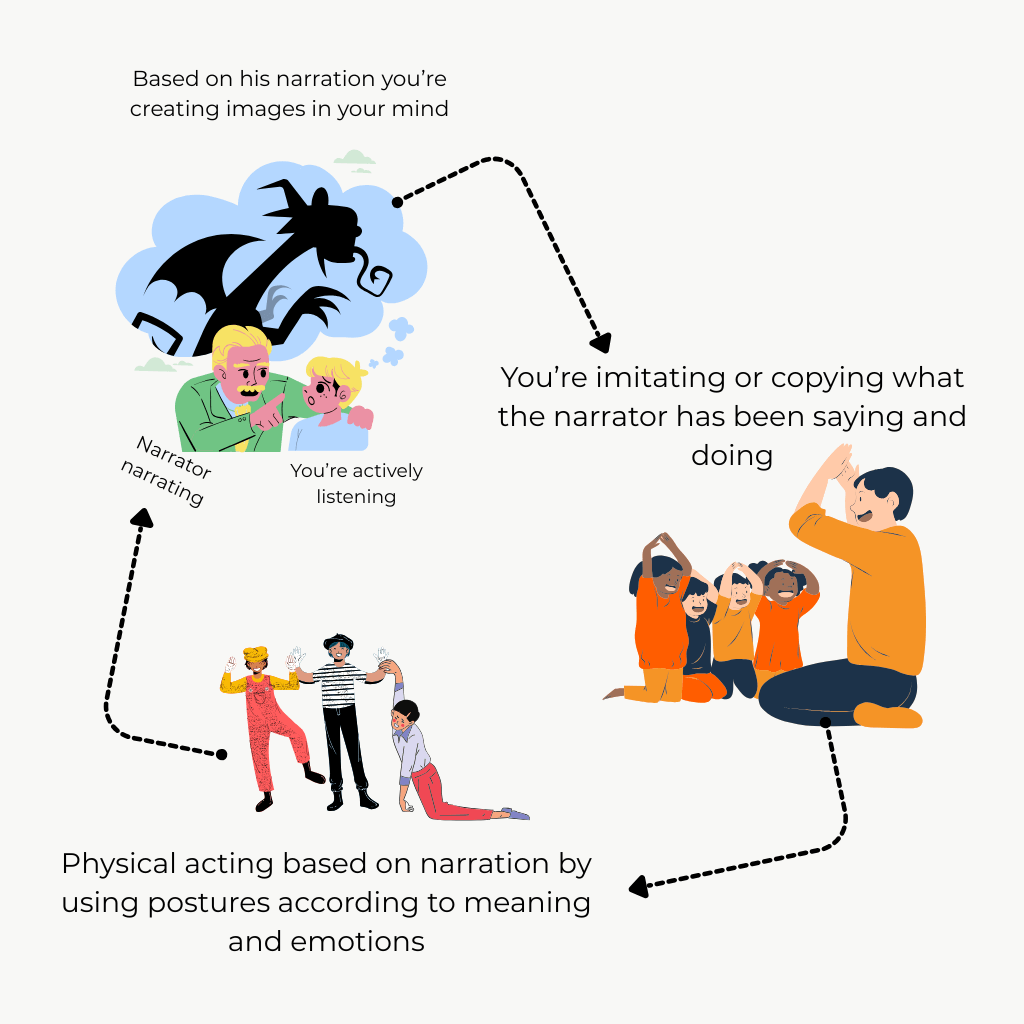
Physical expressions through acting: this idea I’ve got from seeing the acting show of ‘Mummer’ in Jamaica who had been demonstrating the meanings of a cultural story through their physical expressions mutely to the audience. Then, I experimented with this idea while listening to a story with the shadowing technique. To do this, you have to first guess the meaning, then act based on what the word or phrase is expressing. For example, “they went to the shop with no money”, first create an image of what it looks like: for me a guy with formal dress standing in front of a shop, and brings out his pocket japs outside. Then, I have to act exactly the image I created in my mind about this sentence and also loudly shadow it while acting because parroting it keeps the attention and focus vigorous. Then adaptation is another layer of purification of comprehension.
Adaptation
Adaptation refers to various meanings based on contexts. For me, adaptation is absorbing into a new environment or materials gradually, which becomes intuitive and effortless at a certain point. Such as, you have been doing an action for a long time repeatedly, and after a certain amount of time, you will find the action less hard than it was. Means, when you can do an action with less struggle and effort. Exactly, after plenty of repetitions, you will become familiar with the content like story listening. In this stage, you can easily understand 97% the meaning of what the narrator is narrating, and according to this narration, your physical expressions + shadowing will be smooth and fast. You need to continue your shadowing with a physical response to acquire and develop comprehension that lasts long.
Comprehension
Comprehension is the state of being mastered in understanding things and being intuitive in expressing them, which requires plenty of repetitions of the same actions to build complete mastery. It occurs through the training of muscle memory to store the depth of the brain to respond subconsciously whenever it’s needed. And our subconscious mind is way faster than our conscious mind, which reacts to things so quickly that it takes 0.2 seconds. Thus, language acquisition happens subconsciously because it is impossible to react fast in our daily conversation through conscious effort to maintain flow. Though the conscious mind is used for making your ideas logical and forming your thoughts critical, not for expressing these ideas through a language, which happens intuitively.
And comprehension stores our input of a language that we do through the steps I’ve described. After firm establishment of our inputs, we reach an expression state where language expresses with its full potential.
Expression
Expression is the act or medium between a thing and our knowledge about it. And by practicing our language learning through sensory immersion, we develop knowledge or perception about things with full comprehension which leads to expression whenever things we see or think about them because our brain forms the thoughts so quickly that we express it unconsciously in conversations due to our deep repetitions in the process of immersion. For example, In my room I’ve many things; Table, Bed, Bookshelf, and I used to have expressions about these things in my mother tongue, the later it develops into English; whenever I see the bed, my mind automatically forms the word ‘bed’ to express it because plenty of time I’ve encountered this word in my stories & podcast listening, in watching videos while I would imagine the picture of bed shape in my mind, that my brain adapted with this subconsciously and now express it effortlessly.
***Note: Over time, I may upgrade and add the text to strengthen the concept, idea, and comprehension for the reader’s betterment.***
